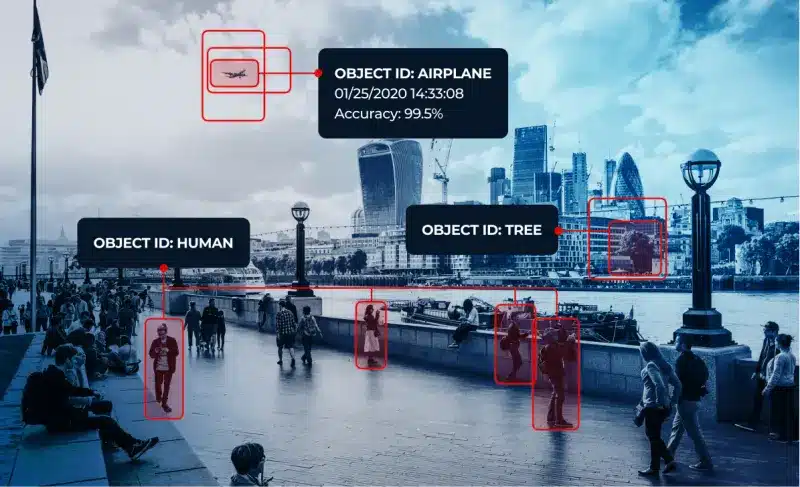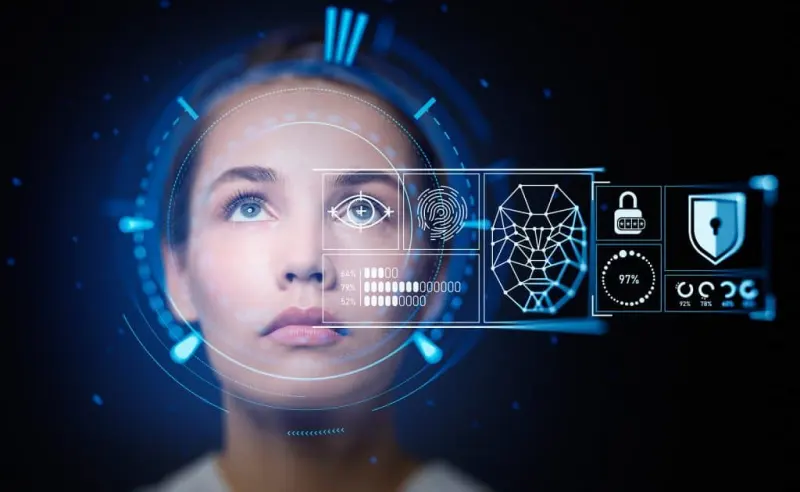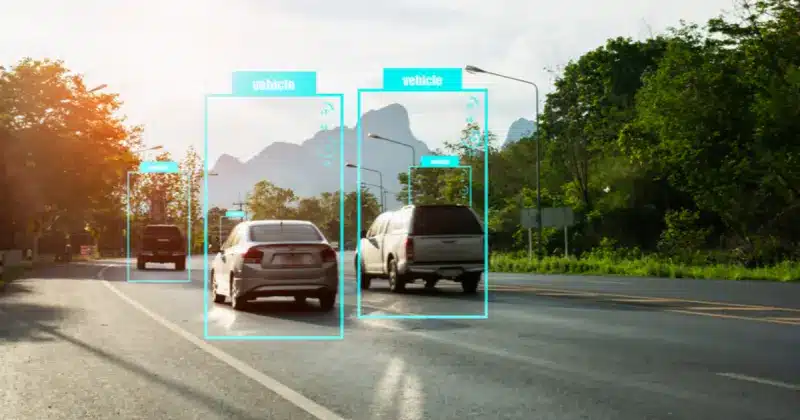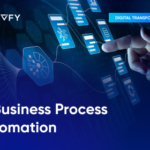The Beginner Guide to AI Image Recognition
- TECHVIFY Team
- 0 Comments
Image recognition is everywhere, from unlocking your phone with your face to finding pictures of your pet in Google Photos. It’s also important in life-saving areas like self-driving cars and healthcare diagnostics. On the fun side, it powers apps that let you identify wine labels just by taking a picture.
As part of computer vision, image recognition is growing quickly. MarketsandMarkets predicts the market will reach $53 billion by 2025, with industries like eCommerce, automotive, healthcare, and gaming leading the charge. With the increasing need for AI in big data analytics and brand recognition, machines are learning to better recognize people, logos, places, objects, and text.
AI-powered image recognition can work on its own or be part of bigger projects like object tracking or segmentation. As this technology gets more common, its uses will keep expanding, giving businesses new ways to automate tasks, analyze data, and improve customer experiences. Knowing how AI image recognition works and how it can help businesses stay competitive in today’s ever-changing digital world is key.
I. AI Image Recognition Definition
AI Image Recognition refers to the task of analyzing images to identify objects and categorize them accurately. Whether referred to as image recognition, photo recognition, or picture recognition, the technology replicates the human ability to visually recognize and classify elements within a scene.
When humans view a scene, we instinctively categorize objects and assign meaning to them. For machines, however, this is a highly complex task that demands substantial computational power. As a result, image recognition has long been a challenging research problem in the field of computer vision.
AI photo recognition
Over time, various techniques have been developed to mimic human vision, but the primary objective remains the same: classifying detected objects into specific categories (i.e., determining what type of object or scene is depicted). This task is often known as deep learning object recognition, as deep learning technologies power many image recognition systems today.
In recent years, machine learning, particularly deep learning, has led to considerable advancements in image recognition and computer vision. As a result, deep learning-based image recognition techniques now offer exceptional performance in terms of both speed (frames per second) and adaptability.
Want to see more AI in different industries? Check here:
II. 3 Ways to Implement AI Image Recognition Models
Python for Image Recognition
When it comes to image recognition, Python is the go-to programming language for most data scientists and computer vision engineers. Python’s versatility is greatly enhanced by its vast collection of libraries specifically designed for AI workflows, including image detection and recognition.
Step #1: To get started with Python for image recognition, you’ll first need to download Python itself and install the necessary packages, such as Keras, which will enable you to run image recognition tasks.
Step #2: Keras is a high-level deep learning API that operates on top of TensorFlow/Python. It simplifies the creation, training, and deployment of machine learning models with easy-to-understand code, making it a popular choice for AI applications.
Step #3: If your local machine doesn’t have a graphics card, don’t worry. You can utilize free GPU instances provided by platforms like Google Colab. To classify images of animals, you can use a well-labeled dataset called Animals-10, which is available for free on Kaggle.
Step #4: After obtaining the dataset from Kaggle (using an API token), you can start coding in Python by uploading your files to Google Drive. From there, you can begin training your image recognition model.
For detailed, platform-specific instructions, numerous tutorials and articles can guide you through the process of setting up your environment, whether on your local machine or in Colab.
Training Custom Models for Image Recognition
A custom model for image recognition is a machine learning model tailored to a specific task. These models are either built from scratch or adapted from pre-existing ones to better fit the unique requirements of your project.
While pre-trained models are robust and have been trained on millions of data points, there are several reasons why you might need to train a custom model. For instance, your dataset may differ significantly from the standard datasets used for training current models.
In such cases, a custom model can be more effective in learning the unique characteristics of your data, ultimately delivering improved performance. Alternatively, standard image recognition models may not meet the accuracy or performance levels required for your new application.
Building a custom model involves collecting high-quality data and performing image annotation. It also requires a thorough understanding of machine learning and computer vision principles. For more insights, check out our article on how to assess machine learning model performance.
Choosing Between Cloud-Based Image Recognition APIs vs. Edge AI
Image Recognition APIs provide a quick and easy way to perform image recognition by utilizing cloud-based services. For example, Amazon Rekognition by AWS Cloud and the Google Vision API by Google Cloud allow developers to recognize objects, faces, text, and even handwriting through simple API calls.
An image recognition API, such as the TensorFlow Object Detection API, is a powerful tool that allows developers to quickly build and deploy image recognition software. These APIs make it easy to retrieve information from an image, such as identifying objects (object detection) or classifying the entire image (image identification).
However, cloud-based solutions have their limitations. They are ideal for prototyping or smaller-scale applications, but challenges arise when dealing with higher-scale production needs:
- Data Offloading: Privacy, security, and legal concerns may arise when sensitive data is sent to cloud servers.
- Mission-Critical Systems: Cloud-based solutions may not be reliable enough for mission-critical applications that require consistent connectivity and bandwidth.
- Real-Time Constraints: Latency issues can be a major bottleneck in real-time applications, and sending large volumes of data to the cloud can be costly and inefficient.
To address these limitations, a recent shift has been towards Edge AI, which brings machine learning closer to the data source. By processing data on the device itself, Edge AI enables real-time image and video recognition without the need to upload data to the cloud. This approach enhances performance, reduces latency, and improves robustness, making it ideal for production-grade systems.
For more information on how image recognition APIs work, which one to choose, and the limitations of these APIs, explore our comprehensive review of the best paid and free Computer Vision APIs.
While computer vision APIs are great for handling individual images, Edge AI excels when it comes to real-time video recognition, thanks to its ability to process visual data quickly and efficiently without relying on cloud infrastructure.
Have a Project Idea in Mind?
Get in touch with experts for a free consultation. We’ll help you decide on next steps, explain how the development process is organized, and provide you with a free project estimate.
III. The Elements of AI Image Recognition
Imagine you’re looking at a picture of a dog. You can easily tell it’s a dog, but an image recognition algorithm works differently. Instead of a definitive answer, it might return a confidence score like 77% dog, 21% cat, and 2% donut. This represents the algorithm’s level of certainty for each possible category.
For the machine to make such a prediction, it needs to go through several steps: it first analyzes the image, compares its findings with data from previous training, and then makes a prediction. This process consists of several tasks, each of which is essential when building a machine learning (ML) model for image recognition.
AI picture recognition
Neural Networks
Machines perceive images differently from humans. While we see objects and scenes, machines interpret images as raster (pixels) or vector (polygons). Because of this, machines need explicit instructions to understand what an image contains. Convolutional Neural Networks (CNNs) are one of the most effective tools for image recognition tasks due to their ability to extract complex features from data through multiple layers.
Here’s a simplified breakdown of the steps an image goes through to become interpretable by a machine:
- Simplification:
The process begins with your original image, often converted to black and white with some blur applied. This step is crucial for feature extraction, where the general shape of the object is defined, and smaller, irrelevant details are ignored without losing important information. - Edge Detection:
The next step is to compute a gradient magnitude. This helps identify the object’s general edges by comparing differences between adjacent pixels. The result is a rough silhouette of the object, helping the machine understand where the object begins and ends. - Outline Definition:
After detecting the edges, non-maximum suppression and hysteresis thresholding are used to refine the edges into clear, clean outlines. This leaves a simple, well-defined shape that the algorithm can recognize and classify.
These steps describe a simplified explanation of how image recognition works for those without domain expertise. There are other ways to build AI-based image recognition models, but CNNs are the most popular due to their ability to perform automatic feature extraction with minimal pre-processing. CNNs essentially handle the complexities of teaching machines how to “see” and recognize images.
Data Annotation for AI Image Recognition
One of the most time-consuming aspects of training an AI model for image recognition is data annotation. This involves labeling thousands, sometimes millions, of images with meaningful tags or categories. These labels create labeled data, which is essential for training an ML algorithm to recognize patterns and make predictions.
Although there are unsupervised machine learning models that do not rely on labeled data, they come with significant limitations. If you want a highly accurate image recognition model that can handle complex predictions, labeled data is critical.
Data annotation in practice means taking a dataset of images and assigning each one a specific class or label. This task is often outsourced to specialized companies, as it requires considerable human labor and can be too resource-intensive for many organizations to handle in-house.
Hardware in AI Image Recognition: Power and Storage
Once you have your network architecture ready and your data annotated, the next step is to train the AI model. However, this is where significant challenges arise, particularly related to hardware limitations.
Training an AI model for image recognition is resource-intensive. Images are large pieces of data that demand substantial computational power and storage capacity. These limitations can extend your project timeline if not managed properly.
To mitigate these hardware issues, you can optimize your data by making it more lightweight. Some of the ways to do this include:
- Image Compression: Reducing the file size of images can significantly lower the computational load without sacrificing too much data quality.
- Black-and-White Conversion: Converting images to grayscale can save both storage space and computational power while retaining enough visual information for the model to make accurate predictions.
These techniques align with the steps CNNs perform during image processing. However, it’s crucial to balance data compression with maintaining high-quality training data. While these measures can help you stay within budget and timeline constraints, maintaining image quality is key to developing an accurate recognition model.
IV. How is AI Image Recognition Being Used in Modern Day?
Across industries, AI image recognition has become increasingly vital as its applications generate significant economic value in sectors like healthcare, retail, security, agriculture, and beyond.
Facial Analysis: A Leading Image Recognition Application
Facial analysis is one of the most prominent uses of image recognition technology. Using modern machine learning methods, AI can analyze any video feed from a digital camera or webcam. In such applications, AI algorithms can perform a variety of tasks in real time, including face detection, pose estimation, face alignment, gender detection, smile recognition, age estimation, and even face recognition through deep convolutional neural networks.
Facial analysis using computer vision involves breaking down visual media to detect identities, intentions, emotional and health states, age, and ethnicity. Some social media tools even go a step further, attempting to quantify perceived attractiveness with a numerical score.
Other tasks related to facial recognition include face identification, face verification, and matching detected faces with images stored in databases. Deep learning techniques enable these systems to recognize individuals in photos or videos, even as they age or under challenging lighting conditions.
One of the most widely used open-source libraries for building AI-powered facial recognition applications is DeepFace, which analyzes both images and videos. To dive deeper into this subject, explore more resources on AI and video recognition for facial analysis.
AI Image Recognition
AI for Medical Image Recognition: Detecting Deadly Diseases
AI image recognition has also made significant advancements in the medical field. For example, AI-driven image recognition software plays a crucial role in the early detection of melanoma, a deadly form of skin cancer. Using deep learning technology, these systems can monitor tumors over time to detect abnormalities in breast cancer scans, improving early diagnosis and treatment outcomes.
Animal Monitoring in Agriculture
In the agricultural sector, image recognition is being used for innovative applications such as animal species identification and behavior monitoring. AI systems enable farmers to remotely monitor livestock, allowing for early disease detection, anomaly detection, enforcement of animal welfare guidelines, and better industrial automation.
Detecting Patterns and Objects with AI
AI-powered image and video recognition technologies are incredibly useful for identifying a wide range of visual elements, including people, patterns, logos, objects, places, colors, and shapes. The highly customizable nature of image recognition allows it to be integrated with various software solutions. For instance, an image recognition system designed for person detection in video frames can be used for people-counting, which is a popular application in retail environments.
Automated Plant Identification: A Growing Field
AI-based plant identification has seen rapid advancements, with applications already being used in research and environmental management. A recent study explored the accuracy of image recognition in identifying plant families, growth forms, life forms, and regional frequency. The tool uses photo recognition to match images of plants against an online database, with impressive results: 79.6% of the 542 species in approximately 1,500 photos were correctly identified, and plant families were accurately classified 95% of the time.
Food Image Recognition: Improving Dietary Assessments
Deep learning-powered image recognition is making strides in food identification, which is crucial for improving dietary assessments. AI applications are being developed to enhance the accuracy of current dietary intake measurements by analyzing food images captured by mobile devices or shared on social media. These apps leverage online pattern recognition to assess the food consumed, making them valuable tools for nutrition tracking, especially in educational settings.
Visual Search: The Future of Image Retrieval
Image search recognition, also known as visual search, uses visual features learned from deep neural networks to create efficient, scalable solutions for retrieving images. The goal in visual search applications is to perform content-based searches for image recognition in online platforms. Researchers are tackling this problem by developing large-scale visual dictionaries based on neural network features, enabling more accurate and faster image retrieval.
V. Upcoming Trends in AI Image Recognition
AI image recognition has experienced significant growth, driven by improvements in deep learning algorithms and the availability of extensive image datasets. Several important trends and factors are shaping the field today.
- Convolutional Neural Networks (CNNs)
CNNs are crucial for image classification and object detection tasks. They excel at recognizing patterns and extracting features from images, which is essential for applications like facial recognition and autonomous driving. For example, Tesla’s self-driving cars rely on CNNs to interpret visual data for navigation and obstacle detection. - Generative Adversarial Networks (GANs)
GANs are used to create realistic images and enhance image quality. They consist of two neural networks that compete to generate high-quality synthetic data. GANs are widely employed in the entertainment industry for generating special effects and realistic animations. - Integration with Augmented and Virtual Reality
Image recognition is increasingly being integrated with augmented reality (AR) and virtual reality (VR) to deliver immersive experiences. In retail, AR applications allow users to try on clothing or makeup virtually, offering personalized shopping experiences. - Transfer Learning
Transfer learning involves using pre-trained models on new datasets to improve efficiency and accuracy while reducing the amount of training data required. In healthcare, for instance, transfer learning is used to adapt pre-trained models for diagnosing diseases based on medical images, such as X-rays or MRI scans.
Conclusion
AI image recognition is transforming industries, from healthcare and automotive to retail and entertainment, by automating tasks, improving decision-making, and enhancing user experiences. As the technology continues to evolve, its applications will only expand, offering businesses a powerful tool to stay competitive in a rapidly changing landscape. Whether it’s identifying objects, analyzing patterns, or improving real-time processes, AI-driven image recognition is the key to unlocking new efficiencies and innovations.
Ready to bring AI image recognition into your business and stay ahead of the competition? TECHVIFY has the expertise to help you implement custom solutions tailored to your needs. Get in touch with us today for a free consultation and discover how our development services can elevate your business and drive real results. Don’t wait—let’s turn your vision into reality with cutting-edge AI technology!
TECHVIFY – Global AI & Software Solution Company
From Startups to Industry Leaders: TECHVIFY prioritizes results, not just deliverables. Accelerate your time to market and see ROI early with high-performing teams, AI (including GenAI) Software Solutions, and ODC (Offshore Development Center) services.
- Email: [email protected]
- Phone: (+84)24.77762.666








